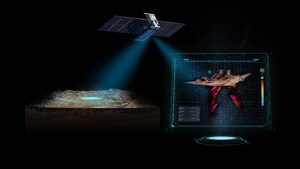Fleet Space's ExoSphere Enhances Barrick Gold's Data-Driven Copper Exploration at Reko Diq
ADELAIDE, Australia, July 9, 2024 /PRNewswire/ -- Fleet Space Technologies, Australia's leading space exploration company, today announced the deployment of its end-to-end mineral exploration solution, ExoSphere, to advance Barrick Gold's copper exploration at its Reko Diq project in Pakistan. Powered by the latest advances in space technology, AI, and 3D multiphysics, ExoSphere is being used to generate 3D subsurface maps of local groundwater systems and copper porphyry complexes for multiple zones of interest, comprising over 1,150 km2 of the Reko Diq project.
"Barrick Gold and Fleet Space are united in our use of cutting-edge technologies to enhance mineral discovery and unlock sustainability benefits across the exploration journey," said Flavia Tata Nardini, Co-Founder & CEO of Fleet Space Technologies. "By applying the latest innovations in space, AI, and 3D multiphysics to copper exploration, we demonstrate a more sustainable, scalable path to achieve the copper supply needed for our clean energy future, in alignment with the United Nations' Sustainable Development Goals (SDGs). We are proud to deploy ExoSphere to advance Barrick Gold's ESG objectives and support the development of a world-class operation at Reko Diq."
Reko Diq is a strategic part of Barrick Gold's copper portfolio and represents one of the largest undeveloped copper-gold projects in the world. The area is one of several volcanic centers in the Chagai mountain range and part of the Tethyan Magmatic Arc which is known to contain significant copper-gold ore deposits of various grades. With plans to begin production in 2028, Reko Diq is poised to be a major contributor to Pakistan's economy, delivering employment opportunities, investment in development programs, and regional economic growth in the Balochistan province in line with Barrick Gold's sustainability pillars.
ExoSphere's end-to-end architecture unlocks new insights and predictive capabilities to enhance outcomes and streamline operations at every stage of the exploration process. Leveraging Fleet Space's satellite network in low Earth orbit, smart seismic sensors enabled with edge computing, and rapid data processing - ExoSphere delivers real-time 3D mapping of mineral systems and AI-powered drill targeting with near-zero environmental impact. This process enables a faster and more efficient end-to-end data journey, making exploration activities more dynamic and precise by giving remote onsite teams access to actionable insights in real-time.
By radically simplifying data acquisition, processing, integration, and insight delivery with space technology and AI, ExoSphere enhances the quality and speed of decision making, while also reducing the environmental footprint of a project. The sustainability benefits and innovative capabilities of ExoSphere were recently recognised at Banksia Foundation's 35th National Sustainability Awards, winning the Climate Technology Impact Award for 2024. ExoSphere's rapid global adoption has propelled Fleet Space's exponential growth over the past year, including a A$50 million Series C funding round, a doubling of its valuation to A$350 million, plans to send a variant of ExoSphere to the Moon in 2026, and recognition as Australia's fastest growing company.
About Fleet Space Technologies
Fleet Space Technologies, Australia's leading space company, is revolutionising humanity's search for critical minerals, space exploration, and defence with its satellite-enabled solutions and AI-powered, end-to-end mineral exploration technology, ExoSphere by Fleet®. Headquartered at the national centre of Australia's space industry in Adelaide, Fleet Space has expanded its global footprint to the US, Canada, Chile, and Luxembourg with over 120+ employees worldwide. In 2023, Fleet Space was named Australia's fastest growing company by the Australian Financial Review.
Photo - https://mma.prnewswire.com/media/2456297/Fleet_Space.jpg
Photo - https://mma.prnewswire.com/media/2456298/ExoSphere.jpg
SOURCE Fleet Space






Share this article